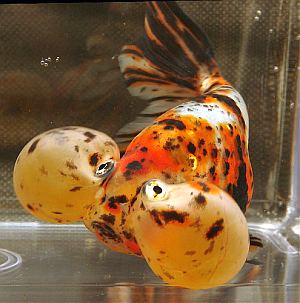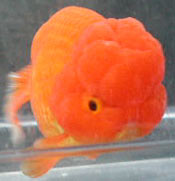
Goldfish (Carassius auratus) are small ornamental freshwater fish that are commonly kept as pets. Goldfish were one of the earliest breed of fish to be domesticated and are still one of the most commonly kept fish in aquariums and outdoor water gardens.
Goldfish were originally domesticated from the Prussian carp (Carassius gibelio), a dark greyish brown carp native to Asia. It was first bred for color in China over 1,000 years ago. Due to selective breeding, goldfish have been developed into many distinct breeds and are now found in various colors, color patterns, forms and sizes far different from those of the original domesticated carpVarieties
The Common, Comet, and Shubunkin varieties of goldfish are similar to wild carp (except for colour). They are hardy and can grow to a large size. Other more fancy varieties have been developed.
The main fancy varieties are:
Black Moor, Bubble eye, Butterfly tail, Calico, Celestial eye, Fantail, Lionchu, Lionhead, Oranda, Panda Moor, Pearlscale, Pompom, Ranchu, Ryukin, Telescope eye, and Veiltail.
Rare fancy varieties include:
Tosakin or curly fantail, Jikin or peacock tail, Shukin, Tamasaba or sabao, Meteor goldfish, Egg-fish goldfish, Curled-gill goldfish or reversed-gill goldfish, Mirror-scale goldfish.
Breeding
Goldfish lay eggs. They produce adhesive eggs that attach to aquatic vegetation. The eggs hatch within 48 to 72 hours, releasing fry large enough to be described as appearing like “an eyelash with two eyeballs”. Within a week or so, the fry begin to look more like a goldfish in shape, although it can take as much as a year before they develop a mature goldfish color; until then they are a metallic brown like their wild ancestors. In their first weeks of existence, the fry grow remarkably fast - an adaptation born of the high risk of getting devoured by the adult goldfish (or other fish and insects) in their environment.
Some scientists believe goldfish only grow to sexual maturity if given enough water and the right nutrition. However, if kept well, they may breed indoors, but not in a small fishbowl. Breeding usually happens after a significant change in temperature, often in spring. Eggs should then be separated into another tank, as the parents will likely eat any of their young that they happen upon. Dense plants such as Cabomba or Elodea or a spawning mop are used to catch the eggs.
Most goldfish can and will breed if left to themselves, particularly in pond settings. Males chase the females around, bumping and nudging them in order to prompt the females to release their eggs, which the males then fertilize. Due to the strange shapes of some extreme modern bred goldfish, certain types can no longer breed among themselves. In these cases, a method of artificial breeding is used called hand stripping. This method keeps the breed going, but can be dangerous and harmful to the fish if not done correctly.[citation needed]
Like other common aquarium fish, such as the guppy, goldfish and other carp are sometimes added to stagnant bodies of water in order to reduce the mosquito populations in some parts of the world, especially to prevent the spread of West Nile Virus, which relies on mosquitoes to migrate. However, the introduction of goldfish has often had negative consequences for local ecosystems.As a result, goldfish are considered a pest in many countries, including the USA

Curly fantail

Bubble eye

Butterfly tail goldfish

Egg-fish goldfish

Lion Head Goldfish

RED cap Goldfish

